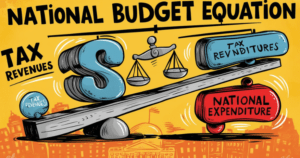Introduction
In the recent past, the Kenyan government has been keen on women and youth empowerment. The government hopes to lift women and youth from poverty.
(Post continues after the photo.)

(Photo by Waka)
Hence, the government came up with the Women Fund and the Youth Fund to able the women and youth get loans for business.
Besides, preferential treatment was accorded the two groups when tendering for County governments and Central government business. The funding by the government was meant to enable the women and youth of Kenya to cross the valley of poverty. Overnight, the women and the youth became tenderpreneurs. The word tenderpreneur is used in Kenya to refer to entrepreneurs who services County and Central government tenders.
Did this happen?
The tenderpreneurs received orders running into millions of shillings from the County and Central governments. With the millions of shillings that was available to the two groups, the country landscape is expected to have changed. The government needed their supplies, and the women and youth had the money to supply what the government required.
However, today the majority of the women and youth have nothing substantial to show for all the efforts. They only have pieces of papers inform of tender documents, purchase invoices, sales documents, copies of cheques or real-time gross settlement (RTGS) and bank statements showing millions in deposits but zero or negative bank balances. Besides, they have loans, taxes and other obligations to pay.
What went wrong?
Today, some women and youth may be worse off than they were before they got into the business of tender supplies. A critical look at the tender business indicate that women and youth experienced numerous problems. One of the problems that the tenderpreneurs inadvertently had was in the costing of the tenders supplies.
The women and the youth saw the big values in the tender documents and did not understand that the big figures were a composition of very many other small figures. Effectively, the tender value is a summary of a very long story with many items.
The long story can be broadly summarized into the following items: selling price, purchase price, other costs, profits, taxes, take-home profits. To help us understand the “long story”, let us look at this example.
Worked example
We will demonstrate the long story using a tender to supply rice worth kshs 17,000,000. Please note that this is a hypothetical figure and a fictitious story – just being creative. We hope that:
- This will enable the tenderpreneurs to understand what went wrong with the huge businesses that they transacted.
- This will make the tenderpreneurs reflect on the way they do their costing.
- This will make the tenderpreneurs understand the importance of consulting experts (accountants, tax experts, lawyers) when in tender business.
The following is the worked example. Note that the terms are explained after the worked example.
a) Selling price of rice (tender value) – kshs 17,000,000.00
b) Purchase price (cost of rice) – kshs 9,000,000.00
c) Other costs (un-receipted)
Opportunity cost 10 % – kshs 1,700,000.00
LPO writing charges 10 % – kshs 1,700,000.00
Rice evaluation – kshs 1,000,000.00
Payment facilitation. – kshs 1,000,000.00
Actual payment – kshs 1,700,000.00
Total – kshs 7,100,000.00
d) Total cost (purchases plus other costs) = kshs 9,000,000.00 + kshs 7,100,000.00 = kshs 16,100,000.00 (the kshs 7,100,000.00 has no receipts).
There are other miscellaneous costs such as transport, loading, unloading, phone calls, business lunch, use of motor vehicles, fuel etc. This we give an estimated cost of kshs 400,000.00 (we assume there are no receipts). Hence, total cost is kshs 16,100,000.00 + kshs 400,000.00 = kshs 16,5000,000.00
e) Profits from sale of rice kshs 17,000,000.00 – 16,500,000.00 = kshs 500,000.00.
f) In Kenya, corporate tax is at the rate of 30 %. Therefore, the profits according to KRA and the available documents is kshs 17,000,000.00 – kshs 9,000,000.00 = kshs 8,000,000.00. Hence, tax is 30 % x kshs 8,000,000.00 = kshs 2,400,000.00
Therefore, the tender- preneur made a loss of kshs 2,400,000.00 – kshs 500,000.00 = 1,900,000.00. The extra costs consumed all the tender-preneur’s profits and tax money.
g) Take home profits
Kshs 500,000.00 – kshs 2,400,000.00 = (kshs 1,900,000.00)
h) Explanation of terms
- Selling price – tender values found in tender documents and sales invoices.
- Cost of goods – the price of buying the rice found in purchase invoices.
- Opportunity cost – money paid to make the preferred supplier cede the tender.
- LPO writing – money paid for one to get an LPO.
- Rice evaluation – money paid to get a favourable report of the rice evaluation for quality and quantity.
- Payment facilitation – money paid for processing the payments in the accounts department until the documents get to the cash office.
- Actual payment – there are normally long queues for payments since there are not enough funds. Hence, money is paid to be among the first to be paid when money is available.
The lessons
From the example above, there are several lessons:
a) The tenderpreneurs gave out his/her profits including tax money to people who:
- Received cash – no evidence they were given any money.
- Did not issue invoices to the tenderpreneurs. Hence, cannot claim the expenses for taxation purposes.
- Will not pay any tax on the money they received.
b) The tender value tells a long story. In every tender or any supply to any organization, it is important to understand the story, to get the costing right. Many tenderpreneurs transacted big business (still are) yet they have nothing to show for it today.
c) All costs towards any tender must be receipted. This is the only way one can be able to account for the expenses for taxation purposes.
d) Always remember there will be tax to pay at the rate of 30 %. There is no way a tenderpreneurs will escape the tax because:
- All payments to the tenderpreneurs will be done by cheque.
- The Central government, County governments and any other organization file returns online with KRA. The returns have all details of the business transactions.
- Some customers like the Central government and the County governments are asked by KRA to furnish them with details of all the suppliers.
e) It is possible to transact businesses and instead of making profits make losses.
f) Today many tenderpreneurs have been left with taxes to pay yet they did not make any profits and they have no money.
g) Therefore, it is very important for the tenderpreneurs in Kenya to:
- Learn how to cost their supplies.
- Stop dishing out un-receipted money.
- Remember there will be taxes to pay.
- Decide whether the tender businesses are worth it or not.
Note
This post is meant to enable the tenderpreneurs and any other business person to revisit their business costing. Probably, that is why they do not make money year in year out yet they service numerous orders. Tender-preneurs must always remember that there will be taxes to pay.
Feel free to send us questions or topics on tax and investments in Kenya that you would wish to be covered in this Website.
Disclaimer
This post is for general overview and guidance and does not in any way amount to professional advice. Consequently, www.taxkenya.com, it’s owner or associates do not take any responsibility for results of any action taken on the basis of the information in this post or for any errors or omissions. Kenyan taxpayers must always rely on the most current information from KRA. Tax industry in Kenya is very dynamic.
©Wakaguyu Wa Kiburi
[about-me id=”1″]
Email: taxkenya@gmail.com
Twitter: @taxkenya
Facebook: fb.me/taxkenya
Youtube: youtube/taxkenya.com shows



